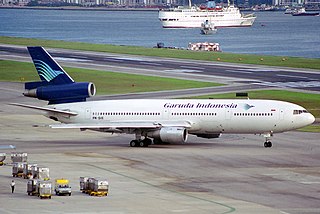
The McDonnell Douglas DC-10 is an American trijet wide-body aircraft manufactured by McDonnell Douglas. The DC-10 was intended to succeed the DC-8 for long-range flights. It first flew on August 29, 1970; it was introduced on August 5, 1971, by American Airlines.

The McDonnell Douglas MD-11 is an American tri-jet wide-body airliner manufactured by American manufacturer McDonnell Douglas (MDC) and later by Boeing. Following DC-10 development studies, the MD-11 program was launched on December 30, 1986. Assembly of the first prototype began on March 9, 1988. Its maiden flight occurred on January 10, and it achieved FAA certification on November 8, 1990. The first delivery was to Finnair on December 7 and it entered service on December 20, 1990.
This is a list of aviation-related events from 1973.
This is a list of aviation-related events from 1978.
This is a list of aviation-related events from 1996:

On August 16, 1987 a McDonnell Douglas MD-82, operating as Northwest Airlines Flight 255, crashed shortly after takeoff from Detroit Metropolitan Airport, about 8:46 pm EDT, resulting in the deaths of all six crew members and 148 of the 149 passengers, along with two people on the ground. The sole survivor was a 4-year-old girl who sustained serious injuries. It was the second-deadliest aviation accident at the time in the United States. It is also the deadliest aviation accident to have a sole survivor.
Spantax S.A. was a Spanish leisure airline headquartered in Madrid that operated from 6 October 1959 to 29 March 1988. Spantax was one of the first Spanish airlines to operate tourist charter flights between European and North American cities and popular Spanish holiday destinations and was considered a major force in developing 20th-century mass tourism in Spain. Its popularity and image faded from the 1970s onward when a series of crashes and incidents revealed safety deficits, which, combined with rising fuel costs and increasing competition, resulted in the company facing severe financial difficulties that led to its demise in 1988.
Aerosucre S.A. is a cargo airline based in Bogotá, Colombia. It began operation in 1969, and operates scheduled international and domestic cargo services throughout Latin America and the Caribbean. Its home base is El Dorado International Airport, Bogotá. Aerosucre has been involved in a number of accidents and incidents during its lifetime, and more recently, internet videos have emerged showcasing reckless behavior by its pilots.

The McDonnell Douglas DC-9 is an American five-abreast, single-aisle aircraft designed by the Douglas Aircraft Company. It was initially produced as the Douglas DC-9 prior to August 1967, after which point the company had merged with McDonnell Aircraft to become McDonnell Douglas. Following the introduction of its first jetliner, the high capacity DC-8, in 1959, Douglas was interested in producing an aircraft suited to smaller routes. As early as 1958, design studies were conducted; approval for the DC-9, a smaller all-new jetliner, came on April 8, 1963. The DC-9-10 first flew on February 25, 1965, and gained its type certificate on November 23, to enter service with Delta Air Lines on December 8.

In aviation, a water landing is, in the broadest sense, an aircraft landing on a body of water. Seaplanes, such as floatplanes and flying boats, land on water as a normal operation. Ditching is a controlled emergency landing on the water surface in an aircraft not designed for the purpose, a very rare occurrence. Controlled flight into the surface and uncontrolled flight ending in a body of water are generally not considered water landings or ditching.

Trans World Airlines (TWA) Flight 159 was a regularly scheduled passenger flight from New York City to Los Angeles, California, with a stopover in Cincinnati/Northern Kentucky International Airport, Kentucky, that crashed after an aborted takeoff from Cincinnati on November 6, 1967. The Boeing 707 attempted to abort takeoff when the copilot became concerned that the aircraft had collided with a disabled DC-9 on the runway. The aircraft overran the runway, struck an embankment and caught fire. One passenger died as a result of the accident.
The article describes accidents and incidents on Korean Air and its predecessor companies Korean National Airlines and KAL.

Garuda Indonesia Flight 865 (GA865/GIA865) was a scheduled international flight from Fukuoka, Japan, to Jakarta, Indonesia via Bali, Indonesia. On 13 June 1996, Flight 865 crashed on its takeoff from runway 16 at Fukuoka Airport. Three of the 275 on board were killed in the accident.

The 1990 Wayne County Airport runway collision involved the collision of two Northwest Airlines jetliners at Detroit Metropolitan Wayne County Airport on December 3, 1990. Flight 1482, a scheduled Douglas DC-9-14 operating from Detroit to Pittsburgh International Airport, taxied by mistake onto an active runway in dense fog and was hit by a departing Boeing 727 operating as Flight 299 to Memphis International Airport. One member of the crew and seven passengers of the DC-9 were killed.








